
The red underwing is a moth of the family Erebidae. The species was first described by Carl Linnaeus in his 1767 12th edition of Systema Naturae.

Catocala is a generally Holarctic genus of moths in the family Erebidae. The genus was erected by Franz von Paula Schrank in 1802. The moths are commonly known as underwing moths or simply underwings. These terms are sometimes used for a few related moths, but usually – especially when used in plural, not as part of a species name – they are used to refer to Catocala only.

Catocala fraxini, the blue underwing or Clifden nonpareil, is a moth of the family Erebidae. The species was first described by Carl Linnaeus in his 1758 10th edition of Systema Naturae.

Catocala fulminea, the yellow bands underwing, is a moth of the family Erebidae. The species was first described by Giovanni Antonio Scopoli in his 1763 Entomologia Carniolica. It is found in central and southern Europe, east Asia and Siberia. The xarippe lineage has been proposed to be a distinct and valid species in its own right, instead of being only subspecifically distinct.

Catocala columbina is a moth of the family Erebidae. It is found in Sichuan, Zhejiang, Taiwan and Japan.

Catocala actaea is a moth of the family Erebidae first described by Rudolf Felder and Alois Friedrich Rogenhofer in 1874.

Catocala agitatrix is a moth of the family Erebidae. It is found in the Russian Far East, China, Korea, Japan.
Catocala seiohbo is a moth of the family Erebidae first described by Katsumi Ishizuka in 2002. It is found in the Chinese provinces of Sichuan, Guangxi, Guangdong and Hunan.

Catocala kuangtungensis is a moth of the family Erebidae. It is found in China and Japan.
Catocala dissimilis is a moth of the family Erebidae. It is found in Russia, China, Korea and Japan.

Ambulyx kuangtungensis is a species of moth of the family Sphingidae first described by Rudolf Mell in 1922.

Catocala pataloides is a moth of the family Erebidae first described by Rudolf Mell in 1931. It is found in northeastern Laos and in the southeastern Chinese provinces of Guangxi, Guangdong and Hunan. and Taiwan.

Catocala tapestrina is a moth of the family Erebidae first described by Frederic Moore in 1882. It is found in China, Bhutan, Nepal and in India.
Catocala giuditta is a moth in the family Erebidae first described by Schawerda in 1934. It is found in Algeria.
Catocala hoenei is a moth in the family Erebidae first described by Rudolf Mell in 1936. It is found in Yunnan, China.
Catocala infasciata is a moth in the family Erebidae first described by Rudolf Mell in 1936. It is found in Yunnan, China.
Catocala largeteaui is a moth in the family Erebidae first described by Charles Oberthür in 1881. It is found in China.
Catocala longipalpis is a moth in the family Erebidae first described by Rudolf Mell in 1936. It is found in Yunnan, China.

Catocala obscena is a moth in the family Erebidae first described by Sergei Alphéraky in 1879. It is found in Korea and China.

Rudolf Emil Mell was a German zoologist and entomologist who specialised in Lepidoptera especially Sphingidae and the fauna of China. He was the director of the German-Chinese Middle School at Canton (Guangzhou) for some time. His collection of Sphingidae is held by the Carnegie Museum of Natural History in Pittsburgh. It was purchased by Benjamin Preston Clark.












